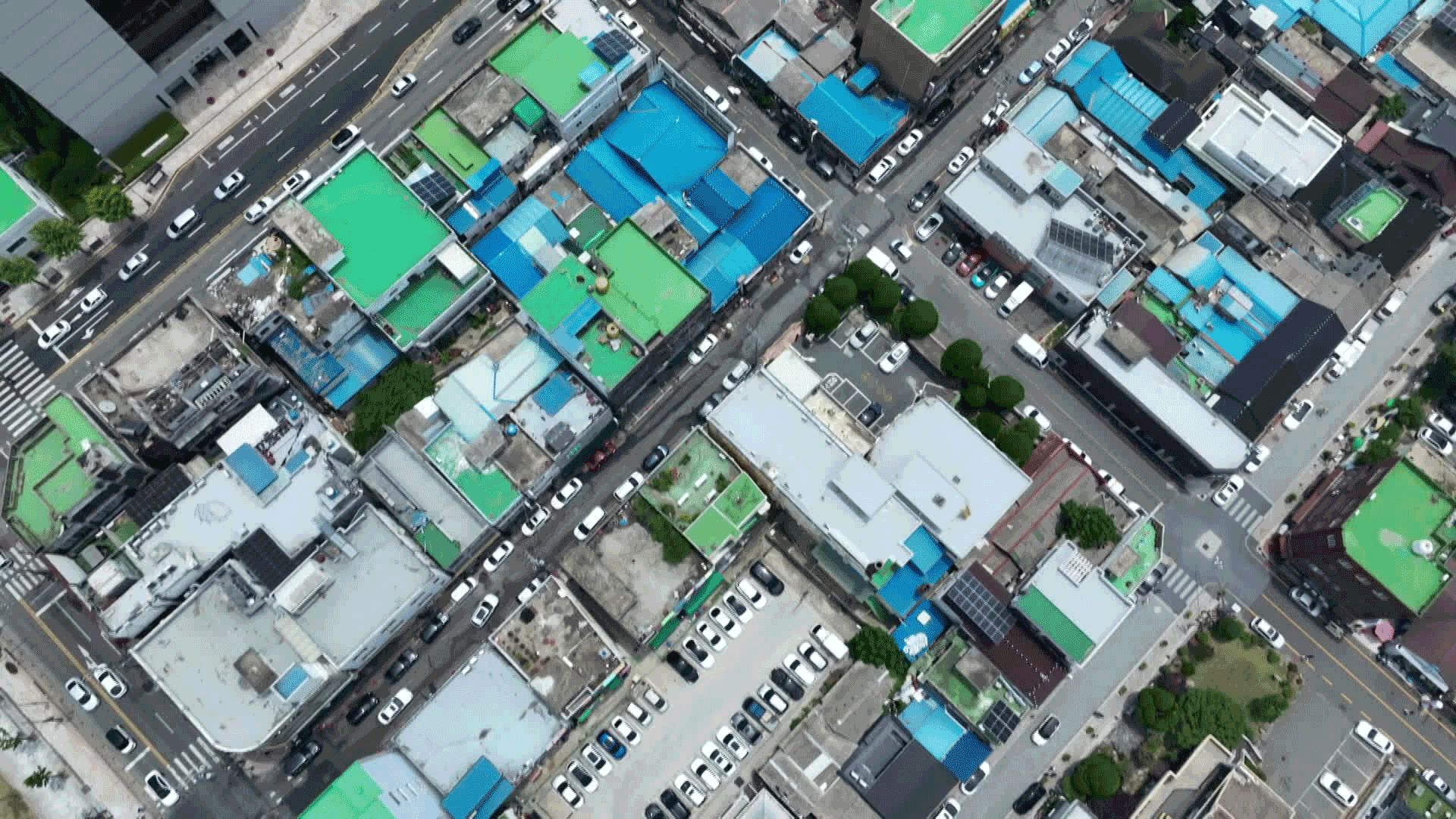[Anchor]
The government has decided to introduce a 'transient population registration system' in 89 local governments where the population is declining.
This new concept of population includes not only residents but also those who stay in the area for purposes such as commuting or tourism.
Reporter Kim Ha-eun reports on whether this can help revitalize the local economy.
[Report]
A flower festival in Gongju, Chungcheongnam-do.
Gongju, with a population just over 100,000, is a declining population area, but due to its many tourist attractions, the average monthly transient population is close to 700,000.
[Park Sang-kyu/Yeonsu-gu, Incheon: "The weather is nice, so after the (festival) ends, we go to a famous restaurant and take my parents to Gongsanseong..."]
'Transient population' is a new concept that includes the 'resident population' with a registered address and the 'staying population' who stay in the area for more than 3 hours a day and at least once a month.
It aims to more broadly assess the population by including the floating population for commuting, schooling, and tourism purposes.
In fact, as of October last year, the staying population in the 89 local governments designated as declining population areas was over 26 million, which is more than five times the resident population.
In response, the Ministry of the Interior and Safety has sent a reference ordinance for the introduction of the 'transient population registration system' to the 89 local governments.
Those who have visited or donated to hometown love funds can register as 'transient population' and will receive various benefits, including accommodation and transportation support.
[Han Yong-deok/Ministry of the Interior and Safety, Balance Development System Division: "By managing those who register and supporting each other, we hope to settle in declining population areas in the future..."]
The government expects that an increase in the transient population will revitalize the local economy and create a virtuous cycle of regional development that encourages an increase in the transient population again.
There are also expectations that tailored population policies will be established, rather than nationwide measures.
As local governments that are betting their survival on increasing the transient population are increasing, attention is focused on whether this will become a new turning point in population policy.
This is KBS News, Kim Ha-eun.
The government has decided to introduce a 'transient population registration system' in 89 local governments where the population is declining.
This new concept of population includes not only residents but also those who stay in the area for purposes such as commuting or tourism.
Reporter Kim Ha-eun reports on whether this can help revitalize the local economy.
[Report]
A flower festival in Gongju, Chungcheongnam-do.
Gongju, with a population just over 100,000, is a declining population area, but due to its many tourist attractions, the average monthly transient population is close to 700,000.
[Park Sang-kyu/Yeonsu-gu, Incheon: "The weather is nice, so after the (festival) ends, we go to a famous restaurant and take my parents to Gongsanseong..."]
'Transient population' is a new concept that includes the 'resident population' with a registered address and the 'staying population' who stay in the area for more than 3 hours a day and at least once a month.
It aims to more broadly assess the population by including the floating population for commuting, schooling, and tourism purposes.
In fact, as of October last year, the staying population in the 89 local governments designated as declining population areas was over 26 million, which is more than five times the resident population.
In response, the Ministry of the Interior and Safety has sent a reference ordinance for the introduction of the 'transient population registration system' to the 89 local governments.
Those who have visited or donated to hometown love funds can register as 'transient population' and will receive various benefits, including accommodation and transportation support.
[Han Yong-deok/Ministry of the Interior and Safety, Balance Development System Division: "By managing those who register and supporting each other, we hope to settle in declining population areas in the future..."]
The government expects that an increase in the transient population will revitalize the local economy and create a virtuous cycle of regional development that encourages an increase in the transient population again.
There are also expectations that tailored population policies will be established, rather than nationwide measures.
As local governments that are betting their survival on increasing the transient population are increasing, attention is focused on whether this will become a new turning point in population policy.
This is KBS News, Kim Ha-eun.
■ 제보하기
▷ 카카오톡 : 'KBS제보' 검색, 채널 추가
▷ 전화 : 02-781-1234, 4444
▷ 이메일 : kbs1234@kbs.co.kr
▷ 유튜브, 네이버, 카카오에서도 KBS뉴스를 구독해주세요!
- Tracking transient population
-
- 입력 2025-08-26 03:23:28

[Anchor]
The government has decided to introduce a 'transient population registration system' in 89 local governments where the population is declining.
This new concept of population includes not only residents but also those who stay in the area for purposes such as commuting or tourism.
Reporter Kim Ha-eun reports on whether this can help revitalize the local economy.
[Report]
A flower festival in Gongju, Chungcheongnam-do.
Gongju, with a population just over 100,000, is a declining population area, but due to its many tourist attractions, the average monthly transient population is close to 700,000.
[Park Sang-kyu/Yeonsu-gu, Incheon: "The weather is nice, so after the (festival) ends, we go to a famous restaurant and take my parents to Gongsanseong..."]
'Transient population' is a new concept that includes the 'resident population' with a registered address and the 'staying population' who stay in the area for more than 3 hours a day and at least once a month.
It aims to more broadly assess the population by including the floating population for commuting, schooling, and tourism purposes.
In fact, as of October last year, the staying population in the 89 local governments designated as declining population areas was over 26 million, which is more than five times the resident population.
In response, the Ministry of the Interior and Safety has sent a reference ordinance for the introduction of the 'transient population registration system' to the 89 local governments.
Those who have visited or donated to hometown love funds can register as 'transient population' and will receive various benefits, including accommodation and transportation support.
[Han Yong-deok/Ministry of the Interior and Safety, Balance Development System Division: "By managing those who register and supporting each other, we hope to settle in declining population areas in the future..."]
The government expects that an increase in the transient population will revitalize the local economy and create a virtuous cycle of regional development that encourages an increase in the transient population again.
There are also expectations that tailored population policies will be established, rather than nationwide measures.
As local governments that are betting their survival on increasing the transient population are increasing, attention is focused on whether this will become a new turning point in population policy.
This is KBS News, Kim Ha-eun.
The government has decided to introduce a 'transient population registration system' in 89 local governments where the population is declining.
This new concept of population includes not only residents but also those who stay in the area for purposes such as commuting or tourism.
Reporter Kim Ha-eun reports on whether this can help revitalize the local economy.
[Report]
A flower festival in Gongju, Chungcheongnam-do.
Gongju, with a population just over 100,000, is a declining population area, but due to its many tourist attractions, the average monthly transient population is close to 700,000.
[Park Sang-kyu/Yeonsu-gu, Incheon: "The weather is nice, so after the (festival) ends, we go to a famous restaurant and take my parents to Gongsanseong..."]
'Transient population' is a new concept that includes the 'resident population' with a registered address and the 'staying population' who stay in the area for more than 3 hours a day and at least once a month.
It aims to more broadly assess the population by including the floating population for commuting, schooling, and tourism purposes.
In fact, as of October last year, the staying population in the 89 local governments designated as declining population areas was over 26 million, which is more than five times the resident population.
In response, the Ministry of the Interior and Safety has sent a reference ordinance for the introduction of the 'transient population registration system' to the 89 local governments.
Those who have visited or donated to hometown love funds can register as 'transient population' and will receive various benefits, including accommodation and transportation support.
[Han Yong-deok/Ministry of the Interior and Safety, Balance Development System Division: "By managing those who register and supporting each other, we hope to settle in declining population areas in the future..."]
The government expects that an increase in the transient population will revitalize the local economy and create a virtuous cycle of regional development that encourages an increase in the transient population again.
There are also expectations that tailored population policies will be established, rather than nationwide measures.
As local governments that are betting their survival on increasing the transient population are increasing, attention is focused on whether this will become a new turning point in population policy.
This is KBS News, Kim Ha-eun.
이 기사가 좋으셨다면
-
좋아요
0
-
응원해요
0
-
후속 원해요
0











![[속보] 이 대통령 “국방비 증액할 것…북한 도발 <br>대응하며 북미대화”](/data/layer/904/2025/08/20250826_P5ExEh.jpg)

![[속보] 대통령실 “한미정상회담서 농축산물 추가 개방 거론 안 돼”](/data/layer/904/2025/08/20250826_RHLdzj.jpg)


이 기사에 대한 의견을 남겨주세요.